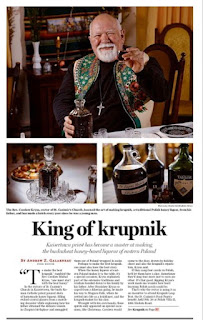Family Egg Rituals of Poland
Why All This Fuss About Easter Eggs!
PolAm
Family egg rituals
As the quintessential natural icon
of life, the egg joins flowers/branches denoting joy, and the sunrise inspiring hope, as God-made celebrations of Polish Resurrection spirituality. Bonded by
ageless families to man-made food: rising breads, sweet pastries, bitter
horseradish, and savory smoked meats, become symbols of something more, once
touched with the supernatural hand of a priestly blessing. The Polish family
Easter table is a most unique and vivifying food and faith festival.
The ancients used eggs to induce, purify
and protect. PolAm families strike up rituals not just to surface old pagan
beliefs in domestic spirit patrons, but to feast at a Christ-transformed meal
welcoming society's forlorn and forgotten, while nourishing body, spirit, and
the soul.
What are some of these sacred
Catholic family egg rites?
Blessing Bringing symbolic
foods to the Lord's Garden Tomb in church for a priest 's blessing is
emblematic of the Polish family Easter. Eggs, cross bread, and smoked meats (among
the most ancient of foods), literally break-the-fast of 40 Lenten
days. Moreover, an egg represents Jesus' tomb. Its hard shell recalls the
rock; and the yolk, the sunrise of Easter morning’s procession. Cracking a
blessed egg represents Jesus, once-and-for-all, crushing the chains of
death.
The proximity of the blessing ritual
to the prayer Vigil before the Garden Sepulchre adds profound spiritual meaning
to the Easter meal. Families pray and light memorial candles for deceased loved
ones who passed the blessing practice on to them. Households present the
"fruits" of their Lenten fasting at the image of Jesus in the
response of death. Monetary donations equivalent of their sacrifices identify
the needy and rejected of our society with the tortured and executed Son of
God, our true hope and solace. In this manner households invite the less
fortunate, in the person of the Risen Savior, to their Easter holyday
table fellowship.
Welcoming/Sharing Meal hospitality rituals
are a part of popular domestic and wedding customs. The familiar bread and salt greeting, becomes a sliced hard-boiled egg sharing during Paschal holyday table grace. The
head of the household shares quartered eggs garnished with horseradish and/or
sprinkled with pepper with each family member. As with the bread-breaking
ritual of the Christmas wafer, personalized wishes chime along with the resounding festal greeting, "Christ is risen!"
Gift-giving during precarious seasonal transitions, fall to winter,
spring to summer, can ease trying human passages, such as courtship or youthful growing pains. A century or two ago the village matchmaker would carry
a basket of written eggs when interceding for a maiden's hand in
marriage. Exchanging the basket for a hand-embroidered hankie sealed the
deal. The engaged guy then sported his girl's handiwork in his breast
pocket.
Presenting some mischievous suitors
with pisanki would spare a talented gal from a dousing. Guys then, collected their bounty, sold them, and threw a Dyngus Day dance.
A culinary prayer for deceased loved
ones, meant leaving and sometimes sharing eggs at gravesite memorial meals.
This spring/summer feasting unearths a possible trans-cultural connection with the
once popular American cemetery picnic (Forest Lawn Cemetery, Buffalo, NY or www.atlasobscura.com/articles/picnic-in-cemeteries-america).
Egg Writing - pisanki: Michael, the Archangel, wields his first Spring sword of lightning
to break open pussy willow catkins. The Polish egg writer captures his
celestial fire, lights a candle, and writes colorful motifs of Resurrection and
renewal on an egg shell.
I often hear the natural symbols of
the pisanka reverberate the lyrics of Polish Lenten and Easter hymns.
Phrases like "shadowy sun and weeping stars" mimic God's passion
through to the Almighty's victory in its chanted Easter Sunday counterpart:
"sun and moon shine more resilient" honoring Christ's holy/happy day of
all days. The depth perception of a family or community artist reveals these mystical
wonders, stylizing natural beauty on a written egg.
Playing is an enjoyable aspect of ritual which stimulates a child's imagination.
Tapping the narrower ends of two eggs together, competitors ascertain the
"strongest". It’s another fun, action-sign of divine supernatural power
overcoming its weaker opposing force, death. Louisiana kids call it
“pocking,” from the French word for Easter, Pâques.
Rolling, the Slavic equivalent of the
Germanic hunt, for centuries had Easter Week rules governed by municipal
law. Eggs rolled down the incline of traditional mounds or hollowed out
tree trunks represent rolling away the stone and opening the Lord's empty Tomb.
As blessed hospitality food,
artistic representations of nature transfigured by eternity, elements of sacred
play, or a symbolic smoothing-over of personal/relational challenges, eggs
have a significant human-divine bonding role in the Polish family
celebration of Easter. Perhaps that's why "Enjoy a tasty egg" is yet
another way to say, "Happy Easter" or "Wesołego Alleluia!"
“Christ is risen!”
© March 2020, 2024 Rev Dr Czeslaw M Krysa, Senior Parochial Vicar
Church of St Casimir, Buffalo, NY














Comments
Post a Comment